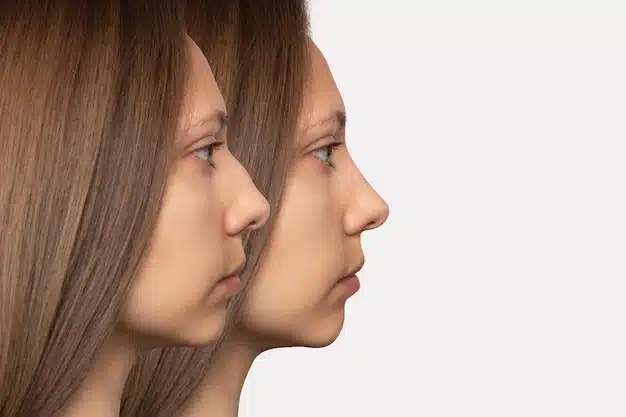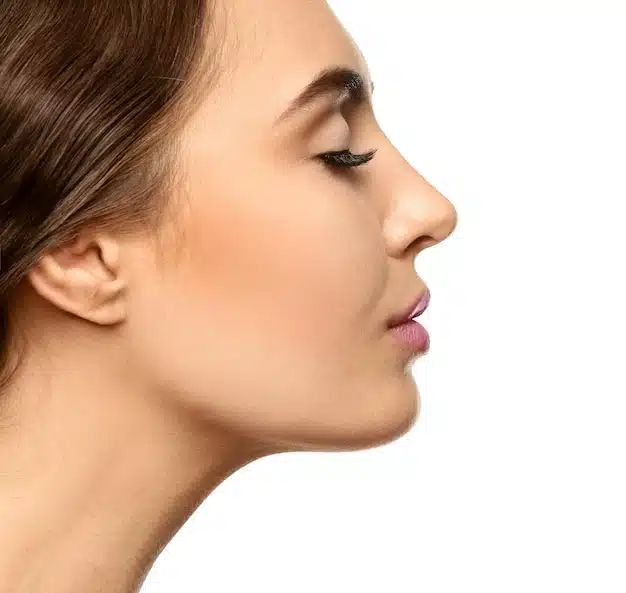The Life-Changing Benefits of Rhinoplasty for Breathing

Rhinoplasty for better breathing isn’t just about aesthetics—it’s also a powerful solution for breathing problems. By correcting structural issues like a deviated septum, nasal valve collapse, or enlarged turbinates, functional rhinoplasty improves airflow, reduces snoring, and enhances overall respiratory health. This procedure can be life-changing, helping patients breathe easier, sleep better, and enjoy an improved quality of life.
Rhinoplasty for breathing problems
Rhinoplasty, commonly known as a “nose job,” significantly improves breathing by correcting structural nasal issues. Key points include:
- Targets nasal obstructions causing breathing difficulties, improving airflow and respiratory comfort.
- Straightens a deviated septum, enhancing nasal airflow and reducing chronic congestion.
- Reduces enlarged turbinates to significantly improve breathing.
- Strengthens collapsed nasal valves, restoring airflow and preventing future blockages.
- Often combined with septoplasty for comprehensive functional and aesthetic results.
- Improves sleep quality, reduces snoring and sleep apnea symptoms, and decreases sinus infection frequency.
- Recommended if experiencing chronic congestion, persistent nasal breathing difficulties, frequent sinus infections, or sleep disruptions due to nasal blockage.
- Consultation with a board-certified surgeon specializing in functional rhinoplasty is essential for personalized guidance, benefits, and risk assessment.
Common Causes of Breathing Issues Addressed by Rhinoplasty
- Deviated Septum: The septum is the cartilage in the nose that separates each nostril; when it is deviated (crooked or off-center), one side of the nose becomes narrower and obstructs airflow. This condition can go undetected for years until an individual begins to suffer from chronic nasal congestion or difficulty breathing.
- Nasal Valve Collapse: This occurs when the nasal valve, the narrowest part of the nasal airway, weakens or collapses. This leads to a drastic decrease in airflow, which can prevent you from breathing properly while exercising or lying down.
- Swollen Turbinates: Small parts inside the nose that sift and saturate the air you take in. Anything that causes inflammation can cause these structures to become enlarged, and if it occurs enough they will start blocking airflow.
- Nasal Trauma or Injury: Nose fractures and other injuries can change the anatomy of the nasal passages, causing chronic breathing problems.
How Rhinoplasty Surgery Can Improve Breathing
- Enhanced Airflow: Functional rhinoplasty reshapes internal nasal structures to directly improve airflow, alleviating congestion and facilitating easier breathing.
- Correction of Structural Issues: Addresses common nasal obstructions such as deviated septum, nasal valve collapse, or naturally narrow airways, significantly enhancing nasal breathing.
- Injury Repair: Effectively treats nasal trauma from accidents or injuries, restoring functionality and improving airway efficiency.
- Congenital Corrections: Corrects congenital nasal deformities, optimizing nasal passage shape for improved breathing and overall respiratory function.
- Improved Quality of Life: Many patients experience substantial relief from chronic nasal blockage, enhancing their ability to breathe comfortably during daily activities and physical exercise.
- Reduction in Snoring: By improving airflow, rhinoplasty reduces or eliminates snoring, contributing to better sleep quality and overall health.
Long-Term Health Benefits of Improved Breathing Post-Rhinoplasty
- More Restful Sleep: If you suffer from nasal obstruction, you might not be getting a good night’s rest. Sleep apnea is a serious disorder in which your breathing repeatedly stops when you sleep. Since a nose job generally enhances nasal airflow, symptoms like nasal congestion and snoring may lessen or disappear completely, resulting in quality rest, and improving energy levels.
- Better Physical Performance: Athletes or those who perform regular physical activities require proper nasal breathing to function at an optimal level. Oxygen makes its way into the blood which allows the runner to improve their speed, endurance, and performance.
- Better Daily Comfort: If you regularly wake up and feel like you cannot breathe through your nose, these types of discomfort can be constant for you. It eliminates these problems and allows patients to breathe freely and effortlessly throughout the day.
- Reduced Risk of Infections: When nasal airflow is obstructed, mucus can build up in the nasal passages, increasing the likelihood of frequent infections such as sinusitis. By correcting structural issues, rhinoplasty helps improve drainage and reduce the risk of infection.
- Enhanced Concentration and Mental Clarity: Improved oxygen flow to the brain has been shown to enhance cognitive function and reduce feelings of fatigue or fogginess. This means patients often notice improved focus and mental clarity post rhinoplasty.
Who Is a Good Candidate for Functional Rhinoplasty?
If you’re experiencing any of the following symptoms, you might be a good candidate for functional rhinoplasty:
- Chronic Nasal Congestion or Difficulty Breathing
- History of Nasal Injury
- Sleep Issues Related to Nasal Obstruction
- Failed Medical Treatments
- Desire to Address Both Cosmetic and Functional Concerns
It’s important to consult with a board-certified plastic surgeon who specializes in functional rhinoplasty to assess your specific condition and determine the best approach for your unique needs.

Healing and Recovery After the Procedure
The process of recovery is similar for most patients and includes the following sequence following functional rhinoplasty:
- Swelling and Bruising: The initial swelling and bruising that presents will typically settle around the nose and eyes for the first 1–2 weeks postoperatively. It is only a natural part of healing.
- Clear breathing: Although swelling in your septum might initially make it more difficult to breathe through your nose, most patients realize a dramatic improvement in the first couple of weeks from when their swelling subsides.
- Full Recovery Timeline: Many patients can resume normal activities in about a week, however, it can take several months for the nose to be fully healed and for all breathing improvements to come into effect.
- Follow-Up Appointments: Regular follow-up visits with your surgeon will ensure that the healing process is occurring correctly and any concerns can be taken care of soon.
Why choose Facial Plastic Surgeon Dr. Yamasaki for your Functional rhinoplasty?
- Renowned Expertise: Board-certified and Harvard-trained facial plastic surgeon, specialized in both functional and aesthetic rhinoplasty.
- Prestigious Affiliations: Associated with Penn Medicine and experienced at top institutions, ensuring high-quality, multidisciplinary care.
- Personalized Care: Customized surgical plans tailored to your specific facial features, breathing needs, and aesthetic goals.
- Extensive Experience: Successfully performs numerous complex rhinoplasty procedures, including revision and functional surgeries.
- Innovative Techniques: Utilizes advanced surgical and non-surgical methods for optimal, natural-looking results.
- Patient-Focused Approach: Known for exceptional bedside manner, detailed patient education, and compassionate, individualized care.
Transform Your Health with Rhinoplasty
Rhinoplasty is not just for aesthetics — its functional benefits can significantly improve your breathing and in turn, the quality of your life. Through correcting structural nasal issues, you can find relief from long-term nasal congestion, improved sleep, better physical performance, or even just more daily comfort. Functional Rhinoplasty can greatly improve your health as well as your appearance.
Dr. Alisa Yamasaki, serving New Jersey and Philadelphia, is a trusted specialist in functional and cosmetic rhinoplasty. Schedule a consultation today to discuss how she can help you achieve better breathing and a more confident appearance.
Faqs about Rhinoplasty for Breathing
Rhinoplasty and septoplasty are surgical procedures that improve breathing by correcting structural issues in the nose. Septoplasty focuses on straightening a deviated septum, while rhinoplasty can reshape the nose while also addressing obstructions that affect airflow. In some cases, turbinoplasty or valve repair may be combined to further enhance nasal function and overall breathing quality.
Yes, rhinoplasty can significantly improve breathing by correcting structural issues that obstruct airflow. A functional rhinoplasty addresses conditions like a deviated septum, nasal valve collapse, or enlarged turbinates, which can cause breathing difficulties. By reshaping the nasal passages, this procedure enhances airflow, reduces snoring, and even helps with conditions like sleep apnea. Beyond better breathing, patients often experience improved sleep quality, energy levels, and overall well-being.